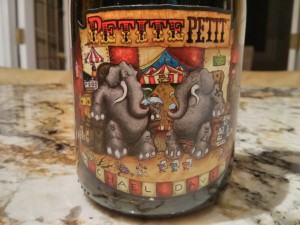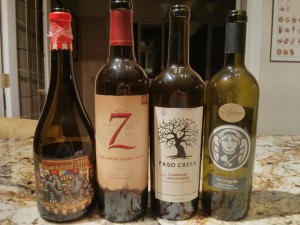 A few days ago I got together with a small group of colleagues and friends for a blind tasting. For some time now I’ve been leading public tastings geared to teaching people about wines, wine regions/types, how to taste wine, and how wine scoring works. To mix things up a little, I wanted to try a new format where everyone brought a concealed bottle of wine to taste and rate blind. Blind tasting can be a real leveller! Scoring followed a format developed by the Executive Wine Seminar in New York. From the flight, which included 8 wines, everyone had to pick their 1st, 2nd and 3rd favorite. For each 1st a wine got it received 3 points; for each 2nd 2 points; for each 3rd 1 point. While such tastings work best with a peer group, we put no restrictions on the wine people could bring: red, white, and rosé – whatever their fancy. Price, critically acclaimed or icon wines with high scores was not the goal. I was looking wines mere mortals could afford, taste and talk about. It’s easy to find a great expensive wine; wine snobs do it all the time. However, it’s much harder to find a great cheap wine!
A few days ago I got together with a small group of colleagues and friends for a blind tasting. For some time now I’ve been leading public tastings geared to teaching people about wines, wine regions/types, how to taste wine, and how wine scoring works. To mix things up a little, I wanted to try a new format where everyone brought a concealed bottle of wine to taste and rate blind. Blind tasting can be a real leveller! Scoring followed a format developed by the Executive Wine Seminar in New York. From the flight, which included 8 wines, everyone had to pick their 1st, 2nd and 3rd favorite. For each 1st a wine got it received 3 points; for each 2nd 2 points; for each 3rd 1 point. While such tastings work best with a peer group, we put no restrictions on the wine people could bring: red, white, and rosé – whatever their fancy. Price, critically acclaimed or icon wines with high scores was not the goal. I was looking wines mere mortals could afford, taste and talk about. It’s easy to find a great expensive wine; wine snobs do it all the time. However, it’s much harder to find a great cheap wine!
On this evening, California dominated the podium. First place went to Michael David’s 2013 “PetitePetit” from Lodi California.  Michael David primarily producers Zinfandel – lots of it, usually with a bit of Petite Syrah thrown in. In this case, “Petite Petit” is a blend of 85% Petite Syrah with a splash (15%) of Petit Verdot. Two wines, also from California tied for 2nd place: the 2012 “Seven Deadly Zins – Zinfandel”, also from Michael David and Paso Creek’s 2012 Cabernet Sauvignon. All wines, at less than $22, represented great value “drink now” wines. Not block busters, but good everyday wines. Third place went to Palma’s 2011 Arcongelo Primativo from Salento in the south of Italy. This was a big dense wine that probably would have beat out the 2nd place wines had it been properly decanted for an hour before we tasted it. Oh well, as the Italian’s might say: così è la vita.
Michael David primarily producers Zinfandel – lots of it, usually with a bit of Petite Syrah thrown in. In this case, “Petite Petit” is a blend of 85% Petite Syrah with a splash (15%) of Petit Verdot. Two wines, also from California tied for 2nd place: the 2012 “Seven Deadly Zins – Zinfandel”, also from Michael David and Paso Creek’s 2012 Cabernet Sauvignon. All wines, at less than $22, represented great value “drink now” wines. Not block busters, but good everyday wines. Third place went to Palma’s 2011 Arcongelo Primativo from Salento in the south of Italy. This was a big dense wine that probably would have beat out the 2nd place wines had it been properly decanted for an hour before we tasted it. Oh well, as the Italian’s might say: così è la vita.
What was clear was that big wines with clean noses won over the crowd. Surprise, surprise. As you will see in the notes on the line-up below, there were some other excellent wines, but funky vegetal noses were just two distracting. While all the top four wines represented great value, it was clear that price is not the best indicator of how good (or crowd pleasing) a wine is. Good marking may have also play a role given that two Michael David wines showed up. Who knows? I should also add that the sole white in the crowd, Tisdale’s non-vintage chardonnay, while not a bad wine, didn’t stand a chance against the bigger red wines. Nonetheless, at $8 it represented excellent value. In future tastings we will focus on a theme or peer group of more similar wines. Something to consider if you are thinking of trying this format for a wine tasting. The following is a summary of scores received (number of..1st/2nd/3rd) from 10 attendees with my tasting notes added as well as my ratings using the 100 point Parking rating scale. Wines are listed in the order they were tasted. All wines were tasted blind. Enjoy.
The following is a summary of scores received (number of..1st/2nd/3rd) from 10 attendees with my tasting notes added as well as my ratings using the 100 point Parking rating scale. Wines are listed in the order they were tasted. All wines were tasted blind. Enjoy.
#1) nv Tisdal Chardonnay (California): $8 – 0 points (0/0/0)
Medium- intensity on the nose. Young wine with some citrus and stone fruit. Dry with medium acidity. On the palate citrus and some tangerine accents. Short finish. A basic wine that was quite quaffable. Chardonnay with some blending? I gave it an 88.
#2) 2013 Torres 5G Five Garnachas Five Generations (Spain): $13 – 2 points (0/1/0)
Medium- intensity on the nose with some green on the nose with little fruit. Dry with medium+ acidity and medium intensity on the palate. Red fruit, black cherry tea leaf with high alcohol. Medium finish. This is a chunky wine that’s not well integrated. BC wine? Score 86.
#3) 2012 Cono Sur Pinot Noir Block 21 Single Vineyard (Aconagua, Chile): $25 – 6 points (2/0/0)
On the nose the intensity seemed low and a bit funky with green, bay-leaf, vegetal aromas. Medium intensity on the palate that featured plumb, bell pepper, black pepper. Tannins medium and dry. Medium finished carried by the high alcohol. Overall the palate is not bad, but the nose is just too distracting. Chilean? Score 85.
#4) 2013 Michael David Petite Petit (Lodi, California): $22 – 16 points (3/3/1)
On the nose medium+ intensity. Young with black fruit, vanillin, eucalyptus/mint cassis and a hint of chocolate. Palate has medium+ intensity with high, dry tannins, high alcohol. Black fruit, cassis and loads of pepper. Long finish carried by the alcohol. Needs some time to open up. Bordeaux blend? Score 91.
#5) 2013 Palo Alto Reserve Cabernet Sauvignon, Carmenere, Shiraz (Maule, Chile): $14 – 4 points (0/1/2)
Young. Medium- intensity on the nose with little fruit, bell pepper and a touch green. On the palate low intensity with medium- tannins and medium alcohol. Plumb, black pepper – a little one dimensional. Short finish. Score 87.
#6) 2012 Paso Creek Cabernet Sauvignon (Paso Robles, California): $17 – 11 points (2/2/1)
On the nose, medium+ intensity with a slightly smoke character, black fruit and Christmas cake. On the palate medium intensity with medium tannins and high alcohol. Plumb, black fruit, pepper, and tea leaf. Medium+ finish. Not bad with good integration. Cab Franc? Score 89.
#7) 2011 Palma Arcongelo Primitivo (Salento, Italy): $27 – 10 points (1/1/5)
On the nose intensity seems low – closed? Young wine with some vegetal characters but also black fruit and licorice. Needs decanting. On the palate intensity is medium+ with high, ripe tannins, plumb, black cherry, chocolate liquor. Med finish. This wine needs time to open up and has lots of potential. It would also go well with a steak! Italian? Reminds me of a ripasso style. Score 90.
#8) 2012 Michael David Zinfandel – Seven Deadly Zins (Lodi, California): $14 – 11 points (2/2/1)
On the nose, medium+ intensity. Young. Black fruit, truffle, tea leaf and blueberry. On the palate medium+ intensity, high alcohol and high, smooth tannins. Plumb, black fruit, pepper, and tea leaf. Medium finish. Score 90; however, this wine ranks higher than #7 on account of the nose.